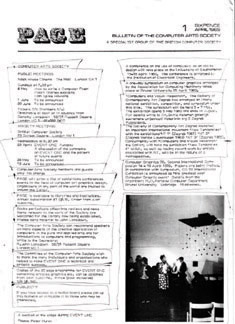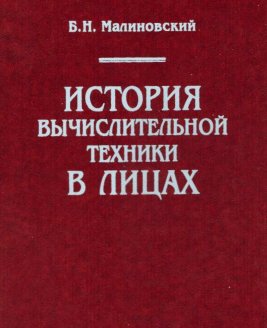PAGE, 1-71 (1969-1985, 2004-2014)
Filed under magazine | Tags: · art history, computer art, computing, history of computing, history of technology, media art, media history, united kingdom

“PAGE is the bulletin of the Computer Arts Society.
The Computer Arts Society was one of the most influential British computer art groups. It was founded in 1968, followed by an inaugural exhibition, Event One, in March 1969 at the RCA. George Mallen, Alan Sutcliffe and Lansdown set up CAS as an offshoot of the British Computer Society, to further the use of computers by artists. CAS flourished through the 1970s and early 80s.
PAGE was initially published from April 1969 until 1985 and was named after the concept of paging (the use of disk memory as a virtual store which had been introduced on the Ferranti Atlas Computer). It featured major British and international computer artists and hosted some fundamental discussions as to the aims and nature of computer art. Its first editor was Gustav Metzger, thereby establishing from the beginning an association with the avant-garde. Metzger was ‘excited’ to discover CAS and ‘people coming together’ as he had ‘felt quite isolated.’ As early as 1961, Metzger had stated that ‘…the artist may collaborate with scientists, engineers.’ As many members were outside of London or overseas, PAGE was an important disseminator of information.”
Publisher Computer Arts Society, London
PDFs (1969-1985 & 2004-2014, updated on 2017-12-2)
PDFs (1969-1985)
Boris N. Malinovsky: Pioneers of Soviet Computing (1995–) [RU, EN]
Filed under book | Tags: · computing, cybernetics, history of computing, history of science, history of technology, soviet union, technology

Boris N. Malinovsky’s Pioneers of Soviet Computing is the English language version of his earlier Russian language The History of Computing in Personalities (in Russian: История Вычислительной Техники в Лицах). Partly technical history and partly a memoir, it is the only existing first person account of the birth of modern computing in Russia, Ukraine, and Belarus. It chronicles the life and work of renowned Soviet computer scientists S.A. Lebedev, V.M. Glushkov, N.P. Brusentsov, I.S. Brook, and many others. It describes numerous indigenous and original Soviet computer hardware projects from the end of the Second World War through the decades that followed, interlaced with commentary on the Soviet political and social systems that constrained rapid and free technological advancement. In addition, this work reviews the various Russian and Ukrainian computing schools ranging from the highly philosophical cybernetics and artificial intelligence to the applied defense computing institutions supporting the military and weapons enterprises. The epic effort to mass produce the Unified System (ES) series of computers – based on the IBM 360 design – is described in depth, along with the political and bureaucratic intrigue and personal and technological struggles that accompanied.
Subjects: Soviet Union, USSR, Electronic Computing, Science, Defense, MESM, BESM, ES, Elbrus, Setun, Cybernetics, Control Computers, Ternary.
Publisher KIT, Kiev, 1995
ISBN 5770761318
384 pages
English edition
Edited by Anne Fitzpatrick
Translated by Emmanuel Aronie
Editorial consultant: Kate Maldonado
First published in 2006
Published electronically by SIGCIS, 2010
Creative Commons license BY-ND 3.0
Authors (via Internet Archive)
Publisher (EN)
via Aymeric Mansoux
Istroiya vychislitelnoy techniki v litsach (Russian, 1995, HTML, added on 2015-1-13)
, Pioneers of Soviet Computing (English, 2nd ed., 2006/2010)
Fred Turner: From Counterculture to Cyberculture. Stewart Brand, the Whole Earth Network and the Rise of Digital Utopianism (2006)
Filed under book | Tags: · collaboration, counterculture, cyberculture, cybernetics, history of communications, history of computing, internet, silicon valley, technology, virtual communities, web, wired

“In the early 1960s, computers haunted the American popular imagination. Bleak tools of the cold war, they embodied the rigid organization and mechanical conformity that made the military-industrial complex possible. But by the 1990s—and the dawn of the Internet—computers started to represent a very different kind of world: a collaborative and digital utopia modeled on the communal ideals of the hippies who so vehemently rebelled against the cold war establishment in the first place.
From Counterculture to Cyberculture is the first book to explore this extraordinary and ironic transformation. Fred Turner here traces the previously untold story of a highly influential group of San Francisco Bay–area entrepreneurs: Stewart Brand and the Whole Earth network. Between 1968 and 1998, via such familiar venues as the National Book Award–winning Whole Earth Catalog, the computer conferencing system known as WELL, and, ultimately, the launch of the wildly successful Wired magazine, Brand and his colleagues brokered a long-running collaboration between San Francisco flower power and the emerging technological hub of Silicon Valley. Thanks to their vision, counterculturalists and technologists alike joined together to reimagine computers as tools for personal liberation, the building of virtual and decidedly alternative communities, and the exploration of bold new social frontiers.
Shedding new light on how our networked culture came to be, this fascinating book reminds us that the distance between the Grateful Dead and Google, between Ken Kesey and the computer itself, is not as great as we might think.”
Publisher University of Chicago Press, 2006
ISBN 0226817415, 9780226817415
x+327+16 pages
Review: Samuel Goëta (Questions de communication, 2013, FR).
PDF (updated 2019-2-25)
Comment (0)
